Technology: World’s first flying race car begins production ahead of its first race this summer
Formula One of the SKIES: World’s first flying race car that can go from 0–62 mph in just 2.8 seconds begins production ahead of its first race this summer
- Ten of the Mk3 ‘Airspeeder’ octocopters are being manufactured in Adelaide
- Each of the 287 lbs craft has a max speed of 75 mph and can climb to 1,640 feet
- The craft will enter races across three different continents in coming months
- Developers say the racing setting will accelerate the development of flying cars
The world’s first flying race car which can go from 0–62 miles per hour in just 2.8 seconds has entered production ahead of its first uncrewed race this summer.
Ten of the craft, named ‘Airspeeder’, like the company that designed them, are being assembled in Adelaide by Alauda Aeronautics.
Completely electric and capable of being piloted remotely, the Airspeeders are scheduled to appear in races across three continents in the coming months.
The ‘octocopter’ craft sports eight rotor blades surrounding a central carbon-fibre cockpit and is capable of maximum speeds of 75 miles per hour.
According to the developers, racing applications will help accelerate the development of flying cars and lead to faster mass-adoption of the technology.
The announcement comes just three months after an Airspeeder prototype went out of control at the Goodwood Aerodrome, West Sussex.
The craft — which was being controlled remotely — soared some 8,000 feet up into a Gatwick Airport flight path before crashing near houses in Chichester.
Scroll down for video


The world’s first flying race car (pictured)— which can go from 0–62 miles per hour in just 2.8 seconds — has entered production ahead of its first uncrewed race this summer


Ten of the craft (pictured) — named ‘Airspeeder’, like the company that designed them — are being assembled in Adelaide, South Australia by Alauda Aeronautics
‘Some of the very first Mercedes, Bentleys and Renaults were racing cars,’ said Airspeeder and Alauda Aeronautics founder Matthew Pearson.
‘The pioneers of these marques knew that in order to advance a mobility revolution, they must build their machines for racing. At Airspeeder, we proudly echo that philosophy.
‘To accelerate the arrival of advanced air mobility technology we must leverage sporting competition.
‘The Airspeeder Mk3 is the result of years of engineering, testing and development with the pure purpose of creating the ultimate performance electric flying car.’
According to the developers, the Airspeeder design is a mixture of a helicopter, a fighter jet and a Formula 1 car, with the cockpit, especially, borrowing from the latter, with a clean construction to allow focus on flying ‘at the absolute limit’.
‘My first principle is that our Speeders are racing craft first,’ said Airspeeder and Alauda Aeronautics head of design, Felix Pierron.
‘In ideating a design approach I explored the classic forms of racing cars from the 1950s and 1960s. This was a time when the requirement for beauty was equal to technological and aerodynamic necessity.
‘As a designer, there is no better place to start. I am excited to see something that started as a vision on paper taken to the air. My dreams are no longer my own, they are now an incredible reality to inspire the world.’
The Mk3 Airspeeder will sport features never-before-seen in an electric, vertical-take-off-and-landing craft, including LiDAR and radar-based collision avoidance systems that will create a ‘virtual forcefield’ around the craft to allow close but safe racing.
Building on the Mk2 version, the upgraded craft will be powered by re-designed batteries which will offer 90 per cent more capacity with only a 50 per cent increase in weight, the developers said.
In addition, the batteries can be fine-tuned to offer different power delivery profiles as required by a given racecourse, for example, as to better accommodate rapid curves and ascents, or to focus on outright straight-line speed.
An innovative ‘slide-and-lock’ system that is new to the Mk 3 design will allow batteries to be rapidly removed and replaced during race pit stops, which the developers in-house pit crews report have gotten down to just 14 seconds.
Ground crew will also be able to monitor the Airspeeders’ status during races thanks to state-of-the-art telemetry systems which will recover terabytes of data from sensors located within every area of the craft.


Completely electric and capable of being piloted remotely, the Airspeeders are scheduled to appear in races across three continents in the coming months


According to the developers, the Airspeeder design (pictured above in sketches) is a mixture of a helicopter, a fighter jet and a Formula 1 car — with the cockpit, especially, borrowing from the latter, with a clean construction to allow focus on flying ‘at the absolute limit’
‘This is pure innovation. We are not constrained by four wheels or a square frame,’ explained Mr Pierron.
‘We are leading an entirely new aesthetic; racing flying vehicles. It will take at least a century to define an era as we are today.
‘I am very proud to fulfil my responsibility of making machines that are as beautiful as they are purposeful.’


Building on the Mk2 version (pictured), the upgraded craft will be powered by re-designed batteries that offer 90 per cent more capacity with only a 50 per cent increase in weight
![]()


